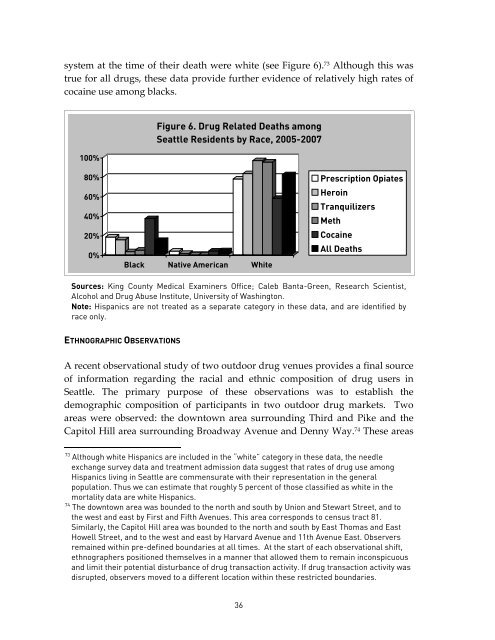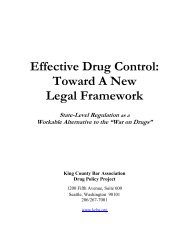RACE AND THE ENFORCEMENT OF DRUG DELIVERY LAWS IN ...
RACE AND THE ENFORCEMENT OF DRUG DELIVERY LAWS IN ...
RACE AND THE ENFORCEMENT OF DRUG DELIVERY LAWS IN ...
You also want an ePaper? Increase the reach of your titles
YUMPU automatically turns print PDFs into web optimized ePapers that Google loves.
system at the time of their death were white (see Figure 6). 73 Although this was<br />
true for all drugs, these data provide further evidence of relatively high rates of<br />
cocaine use among blacks.<br />
100%<br />
Figure 6. Drug Related Deaths among<br />
Seattle Residents by Race, 2005-2007<br />
80%<br />
60%<br />
40%<br />
20%<br />
0%<br />
Black Native American White<br />
Prescription Opiates<br />
Heroin<br />
Tranquilizers<br />
Meth<br />
Cocaine<br />
All Deaths<br />
Sources: King County Medical Examiners Office; Caleb Banta-Green, Research Scientist,<br />
Alcohol and Drug Abuse Institute, University of Washington.<br />
Note: Hispanics are not treated as a separate category in these data, and are identified by<br />
race only.<br />
ETHNOGRAPHIC OBSERVATIONS<br />
A recent observational study of two outdoor drug venues provides a final source<br />
of information regarding the racial and ethnic composition of drug users in<br />
Seattle. The primary purpose of these observations was to establish the<br />
demographic composition of participants in two outdoor drug markets. Two<br />
areas were observed: the downtown area surrounding Third and Pike and the<br />
Capitol Hill area surrounding Broadway Avenue and Denny Way. 74 These areas<br />
73 Although white Hispanics are included in the “white” category in these data, the needle<br />
exchange survey data and treatment admission data suggest that rates of drug use among<br />
Hispanics living in Seattle are commensurate with their representation in the general<br />
population. Thus we can estimate that roughly 5 percent of those classified as white in the<br />
mortality data are white Hispanics.<br />
74 The downtown area was bounded to the north and south by Union and Stewart Street, and to<br />
the west and east by First and Fifth Avenues. This area corresponds to census tract 81.<br />
Similarly, the Capitol Hill area was bounded to the north and south by East Thomas and East<br />
Howell Street, and to the west and east by Harvard Avenue and 11th Avenue East. Observers<br />
remained within pre-defined boundaries at all times. At the start of each observational shift,<br />
ethnographers positioned themselves in a manner that allowed them to remain inconspicuous<br />
and limit their potential disturbance of drug transaction activity. If drug transaction activity was<br />
disrupted, observers moved to a different location within these restricted boundaries.<br />
36

















